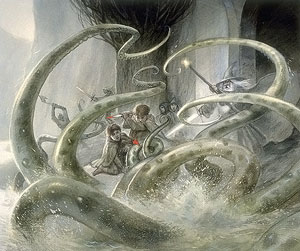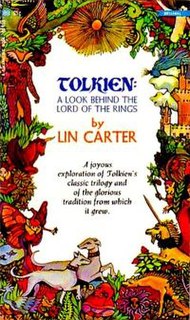
John Ronald Reuel Tolkien, was an English writer, poet, philologist, and academic, who is best known as the author of the classic high fantasy works The Hobbit, The Lord of the Rings, and The Silmarillion.
Christopher John Reuel Tolkien is the third son of the author J. R. R. Tolkien (1892–1973), and the editor of much of his father's posthumously published work. He drew the original maps for his father's The Lord of the Rings, which he signed C. J. R. T.
Hobbits are a diminutive, humanoid race inhabiting lands of Middle-earth in the work of J. R. R. Tolkien. They are also referred to as Halflings.
Samwise "Sam" Gamgee is a fictional character in J. R. R. Tolkien's legendarium. The hobbit Samwise is one of the supporting characters of The Lord of the Rings, in which he fills an archetypal role as the sidekick of the primary protagonist, Frodo Baggins. Sam is a member of the Fellowship of the Ring, which also includes Frodo Baggins, Merry Brandybuck, Pippin Took, Legolas Greenleaf, Gimli son of Gloin, Boromir, Aragorn son of Arathorn, and Gandalf.
Tom Bombadil is a character in J. R. R. Tolkien's legendarium. He first appeared in print in a 1934 poem called The Adventures of Tom Bombadil, which also included Old Man Willow and the Barrow-wight. They were not then explicitly part of the older legends that became The Silmarillion, and are not mentioned in The Hobbit.
Celeborn is a fictional character in J.R.R. Tolkien's Middle-earth legendarium. Celeborn is an Elf, and the husband of Galadriel. He appears in The Lord of the Rings as the Lord of the Galadhrim, and co-ruler along with Galadriel of Lothlórien. He was the father of Celebrían, and thus the grandfather of Arwen Evenstar and her older brothers Elladan and Elrohir. He was also a kinsman of the First Age Elven King Thingol. Celeborn means "(tall) silver tree" in Tolkien's invented language of Sindarin.

Unfinished Tales of Númenor and Middle-earth is a collection of stories and essays by J. R. R. Tolkien that were never completed during his lifetime, but were edited by his son Christopher Tolkien and published in 1980. Many of the tales within are retold in The Silmarillion, albeit in modified forms; the work also contains a summary of the events of The Lord of the Rings told from a less personal perspective.

In J. R. R. Tolkien's fantasy writings, Orcs are a race of creatures who are used as soldiers and henchmen by both the greater and lesser villains of The Silmarillion, The Hobbit and The Lord of the Rings—Morgoth, Sauron and Saruman.

Morgoth's Ring (1993) is the tenth volume of Christopher Tolkien's 12-volume series The History of Middle-earth in which he analyses the unpublished manuscripts of his father J. R. R. Tolkien.

The War of the Jewels (1994) is the 11th volume of Christopher Tolkien's series The History of Middle-earth, analysing the unpublished manuscripts of his father J. R. R. Tolkien.
The Red Book of Westmarch is a fictional manuscript written by hobbits, a conceit of author J. R. R. Tolkien to explain the source of his fantasy writings.

Tolkien fandom is an international, informal community of fans of the works of J. R. R. Tolkien, especially of the Middle-earth legendarium which includes The Hobbit, The Lord of the Rings, and The Silmarillion. "Fandom" is a term used to describe a specific type of fan subculture. "Tolkien fandom" in this sense sprang up in the United States in the 1960s, in the context of the hippie movement, to the dismay of the author, who talked of "my deplorable cultus".

The Watcher in the Water is a fictional creature in J. R. R. Tolkien's Middle-earth legendarium; it appears in The Fellowship of the Ring, the first volume of The Lord of the Rings. Lurking in a lake beneath the western walls of the dwarf-realm Moria, it is said to have appeared after the damming of the river Sirannon, and was first recorded by Balin's dwarf company 30 or so years before the beginning of Fellowship of the Ring. The origins of the creature are not described in Tolkien's works, but writers have compared it to squids, the legendary kraken, and even to Tolkien's dragons.
During 1955 and 1956, a condensed radio dramatisation of The Lord of the Rings was broadcast in twelve episodes on BBC Radio's the Third Programme. These radio broadcasts were the first dramatisation of The Lord of the Rings, a book by J. R. R. Tolkien, the final volume of which, The Return of the King, had been published in October 1955. Since the BBC did not generally keep long-term archives of its productions at that time, no copies of the adaptation are known to have survived.
Tolkien's legendarium is the body of J. R. R. Tolkien's mythopoeic writing that forms the background to his The Lord of the Rings.
Tolkien worked and re-worked the components of his legendarium throughout his adult life, a period of more than 50 years; the earliest drafts, published in The Book of Lost Tales (1983), date to 1916.

Tolkien: A Look Behind "The Lord of the Rings" is a study of the works of J. R. R. Tolkien written by Lin Carter. It was first published in paperback by Ballantine Books in March 1969 and reprinted in April 1969, April 1970, July 1971, July 1972, February 1973, July 1973, June 1975 and November 1977, after which it went out of print for over twenty-five years. The book has been translated into French, Japanese and Polish. A new edition updated by Adam Roberts was published by Gollancz in August 2003; it constituted both the first British edition and first hardcover edition. The first American hardcover edition was published by Tor Books in 2004.
While highly creative, the fiction of J. R. R. Tolkien was influenced by a number of sources. Tolkien was inspired by his academic fields of philology and early Germanic literature, especially poetry and mythology, as well as a wide range of other beliefs, culture, and experiences.
The works of J. R. R. Tolkien, especially The Hobbit and The Lord of the Rings, have exerted considerable influence since their publication. A culture of fandom sprang up in the 1960s, but reception by the establishment of literary criticism has been slower. Nevertheless, academic studies on Tolkien's works have been appearing at an increasing pace since the mid-1980s.

The Silmarillion (pronounced: /sɪlmaˈrɪljɔn/) is a collection of mythopoeic works by English writer J. R. R. Tolkien, edited and published posthumously by his son, Christopher Tolkien, in 1977, with assistance from Guy Gavriel Kay. The Silmarillion, along with J. R. R. Tolkien's other works, forms an extensive, though incomplete, narrative that describes the universe of Eä in which are found the lands of Valinor, Beleriand, Númenor, and Middle-earth, within which The Hobbit and The Lord of the Rings take place.










